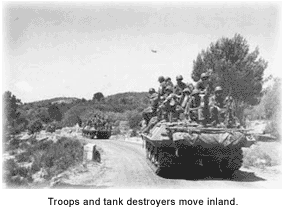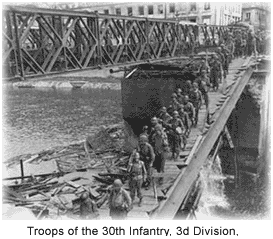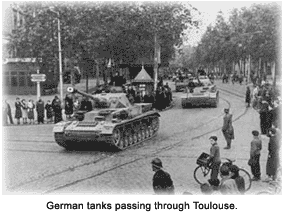Introduction
On August 15, 1944, Allied forces in the European Theater during World War II invaded southern France, following the June 6 Invasion of Normandy, France, commonly referred to as "D-Day." That invasion, Operation Anvil, later renamed "Dragoon," occurred at the Gulf of Leon east of Marseilles. Operation Anvil was planned as a supporting action for Operation Overlord, the Allied attack on Normandy. The Anvil invasion marked the beginning of one of the most successful, but controversial campaigns of the war.
 Like a hammer striking an anvil, the successful Allied advance up the Rhone River valley from the gulf forced the Wehrmacht (German army) into retreat toward the north. The Germans retreating from the west by the post-Normandy Allied push, and their compatriots retreating from Operation Anvil, caused considerable confusion in the Wehrmacht ranks — which allowed the Allies some accelerated advancement.
Operation Anvil fell both geographically and chronologically between two much larger Allied efforts in northern France and Italy, so both its conduct and its contributions have largely been ignored.
Until the opening of Antwerp, Holland, in December 1944, the supply route from southern France supplied more than one third of the Allied logistical needs in northern France. In addition, the Southern France Campaign resulted in the arrival of the Third Allied army group opposite the German border. Without that force, General Eisenhower's army groups would have been stretched thinner and pressed harder during the German Ardennes offensive in December of that year. And a more grievous Allied setback in the Ardennes might also have had dire consequences in postwar Europe for the Western Alliance.
The controversy that persists around Anvil concerns not its timing or success, but its very existence. Opponents of Anvil, including Prime Minister Winston Churchill, argued that the invasion of southern France did little more than sap the strength of the Allied Italian Campaign, that drive north up the Italian peninsula to the Julian Alps*.
Like a hammer striking an anvil, the successful Allied advance up the Rhone River valley from the gulf forced the Wehrmacht (German army) into retreat toward the north. The Germans retreating from the west by the post-Normandy Allied push, and their compatriots retreating from Operation Anvil, caused considerable confusion in the Wehrmacht ranks — which allowed the Allies some accelerated advancement.
Operation Anvil fell both geographically and chronologically between two much larger Allied efforts in northern France and Italy, so both its conduct and its contributions have largely been ignored.
Until the opening of Antwerp, Holland, in December 1944, the supply route from southern France supplied more than one third of the Allied logistical needs in northern France. In addition, the Southern France Campaign resulted in the arrival of the Third Allied army group opposite the German border. Without that force, General Eisenhower's army groups would have been stretched thinner and pressed harder during the German Ardennes offensive in December of that year. And a more grievous Allied setback in the Ardennes might also have had dire consequences in postwar Europe for the Western Alliance.
The controversy that persists around Anvil concerns not its timing or success, but its very existence. Opponents of Anvil, including Prime Minister Winston Churchill, argued that the invasion of southern France did little more than sap the strength of the Allied Italian Campaign, that drive north up the Italian peninsula to the Julian Alps*.
 By contrast, defenders of Anvil, mainly Americans, have maintained that even if the rugged Italian campaign could have been accelerated, the operational and logistical difficulties of rapidly crossing the Julian Alps would have been impossible to overcome. In other words, to many American leaders and soldiers, the Italian Campaign looked increasingly like a dead end. Far more significant to the Allied cause in Europe were the capture of Marseilles, France's largest port, and the rapid rehabilitation of the Rhone Valley rail and road networks.
Participants in Operation Anvil/Dragoon
Operation Torch, the Anglo-American landings against French North Africa in November 1942, was followed by Husky, the assault against Sicily in early July 1943, and the invasion of southern Italy in September.
General Jacob Devers, commander of the U.S. Services of Supply in the Mediterranean, was the overseer of Lt. General Alexander M. Patch and his Seventh Army staff, who were the nucleus of Anvil. The operation would consist of the U.S. VI Corps under Maj. General Lucian Truscott with the U.S. Third, 36th, and 45th Infantry divisions, commanded respectively by Maj. Generals John W. "Iron Mike" O'Daniel, John E. Dahlquist, and William W. Eagles. As shipping schedules and the situation ashore allowed, they were to be followed by seven French colonial divisions under the overall command of General Jean de Lattre de Tassigny.
Other elements of the Anvil order of battle included an ad hoc airborne division, the Anglo-American First Airborne Task Force, under Maj. General Robert T. Frederick; the Canadian-American First Special Service Force, an experienced regiment-size commando force; various French special assault detachments and French Partisans and Freedom Fighters. Air support would generally stage out of Corsica, about 100 miles away, supplemented by naval aviation from several escort carriers operating offshore. The latter vessels, together with supporting warships and the entire amphibious assault fleet, were under the control of Vice Admiral Henry K. Hewitt, the veteran commander of the Western Naval Task Force.
The invasion
While planning for Anvil had continued quietly for months, the actual order to proceed came on June 24, only seven weeks preceding the invasion. General Patch had intelligence from French Partisans and Ultra, which together exposed German emplacements, activities and strengths. The time available to prepare was severely limited and tied to rigid schedules.
By contrast, defenders of Anvil, mainly Americans, have maintained that even if the rugged Italian campaign could have been accelerated, the operational and logistical difficulties of rapidly crossing the Julian Alps would have been impossible to overcome. In other words, to many American leaders and soldiers, the Italian Campaign looked increasingly like a dead end. Far more significant to the Allied cause in Europe were the capture of Marseilles, France's largest port, and the rapid rehabilitation of the Rhone Valley rail and road networks.
Participants in Operation Anvil/Dragoon
Operation Torch, the Anglo-American landings against French North Africa in November 1942, was followed by Husky, the assault against Sicily in early July 1943, and the invasion of southern Italy in September.
General Jacob Devers, commander of the U.S. Services of Supply in the Mediterranean, was the overseer of Lt. General Alexander M. Patch and his Seventh Army staff, who were the nucleus of Anvil. The operation would consist of the U.S. VI Corps under Maj. General Lucian Truscott with the U.S. Third, 36th, and 45th Infantry divisions, commanded respectively by Maj. Generals John W. "Iron Mike" O'Daniel, John E. Dahlquist, and William W. Eagles. As shipping schedules and the situation ashore allowed, they were to be followed by seven French colonial divisions under the overall command of General Jean de Lattre de Tassigny.
Other elements of the Anvil order of battle included an ad hoc airborne division, the Anglo-American First Airborne Task Force, under Maj. General Robert T. Frederick; the Canadian-American First Special Service Force, an experienced regiment-size commando force; various French special assault detachments and French Partisans and Freedom Fighters. Air support would generally stage out of Corsica, about 100 miles away, supplemented by naval aviation from several escort carriers operating offshore. The latter vessels, together with supporting warships and the entire amphibious assault fleet, were under the control of Vice Admiral Henry K. Hewitt, the veteran commander of the Western Naval Task Force.
The invasion
While planning for Anvil had continued quietly for months, the actual order to proceed came on June 24, only seven weeks preceding the invasion. General Patch had intelligence from French Partisans and Ultra, which together exposed German emplacements, activities and strengths. The time available to prepare was severely limited and tied to rigid schedules.
 Even as those forces assembled, Allied air attacks against the southern French coastline and the immediate interior, begun on August 5, continued and intensified. To avoid revealing the precise landing area, targets all along the coast were struck. Also attacked were the Rhone River bridges, whose destruction would severely hamper German movements throughout the campaign. At the same time, French Resistance forays against lesser water crossings, rail and communication sites, further paralyzed German movement behind the battle area and seriously degraded internal communications capabilities. Deception efforts on the night before the Anvil landings included dummy paratrooper drops and visits by small fleets of patrol craft, one led by cinema star Lt. Commander Douglas Fairbanks Jr., to other potential landing sites to simulate an invasion force.
On the German side, the attack would come as no surprise. Luftwaffe air reconnaissance had chronicled the Allied naval buildup for General Friedrich Wiese, commander of the defending 19th Army in southern France. But neither he nor his superior, General Johannes Blaskowitz, heading Army Group G, could determine the precise landing area, nor had they the forces to defend the entire coastline. German naval and air power in southern France was extremely weak, and steadily increasing guerrilla attacks by the French Resistance continued to hamper German lines of communication. Nevertheless, the German leaders did what they could to prepare for the assault.
Smaller, but as complex as the Normandy invasion, Operation Anvil employed many simultaneous operations. Preceding the actual landings, air and naval bombardments softened the German defenses. On the night of August 14 and 15, French partisans secured the general beachhead area. Members of the Special Service Force assaulted key German positions overlooking the invasion beaches and sealed off coastal roads, all to prevent German reinforcement of the area. Paratroopers secured Le Muy, a small French town a short distance inland from the landing beaches, which provided protection of the invasion beaches and access to the Argens valley corridor. The actual landings took place, meeting some resistance, but successfully and anti-climatically, at 8 a.m. on August 15, providing additional time for air and naval bombardments.
Even as those forces assembled, Allied air attacks against the southern French coastline and the immediate interior, begun on August 5, continued and intensified. To avoid revealing the precise landing area, targets all along the coast were struck. Also attacked were the Rhone River bridges, whose destruction would severely hamper German movements throughout the campaign. At the same time, French Resistance forays against lesser water crossings, rail and communication sites, further paralyzed German movement behind the battle area and seriously degraded internal communications capabilities. Deception efforts on the night before the Anvil landings included dummy paratrooper drops and visits by small fleets of patrol craft, one led by cinema star Lt. Commander Douglas Fairbanks Jr., to other potential landing sites to simulate an invasion force.
On the German side, the attack would come as no surprise. Luftwaffe air reconnaissance had chronicled the Allied naval buildup for General Friedrich Wiese, commander of the defending 19th Army in southern France. But neither he nor his superior, General Johannes Blaskowitz, heading Army Group G, could determine the precise landing area, nor had they the forces to defend the entire coastline. German naval and air power in southern France was extremely weak, and steadily increasing guerrilla attacks by the French Resistance continued to hamper German lines of communication. Nevertheless, the German leaders did what they could to prepare for the assault.
Smaller, but as complex as the Normandy invasion, Operation Anvil employed many simultaneous operations. Preceding the actual landings, air and naval bombardments softened the German defenses. On the night of August 14 and 15, French partisans secured the general beachhead area. Members of the Special Service Force assaulted key German positions overlooking the invasion beaches and sealed off coastal roads, all to prevent German reinforcement of the area. Paratroopers secured Le Muy, a small French town a short distance inland from the landing beaches, which provided protection of the invasion beaches and access to the Argens valley corridor. The actual landings took place, meeting some resistance, but successfully and anti-climatically, at 8 a.m. on August 15, providing additional time for air and naval bombardments.
 At Hitler's personal order, vital coastal enclaves were to be defended to the last man. However, at that critical juncture in the Southern France Campaign (Anvil), the German High Command began to reevaluate its entire position in the west. By August 16, with many of their divisions in danger of annihilation, the German leaders elected to order a general withdrawal from France. Blaskowitz was to leave strong garrisons at Toulon, Marseille, and several key Atlantic ports.
Stretching their supply lines thin, all Anvil commanders nevertheless agreed that keeping the initiative was paramount. Allied forces struggled northward on the heels of the retreating Germans to meet Eisenhower’s forces — the hammer striking the anvil — to finally drive the Germans out of France.
At Hitler's personal order, vital coastal enclaves were to be defended to the last man. However, at that critical juncture in the Southern France Campaign (Anvil), the German High Command began to reevaluate its entire position in the west. By August 16, with many of their divisions in danger of annihilation, the German leaders elected to order a general withdrawal from France. Blaskowitz was to leave strong garrisons at Toulon, Marseille, and several key Atlantic ports.
Stretching their supply lines thin, all Anvil commanders nevertheless agreed that keeping the initiative was paramount. Allied forces struggled northward on the heels of the retreating Germans to meet Eisenhower’s forces — the hammer striking the anvil — to finally drive the Germans out of France.